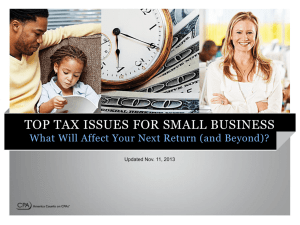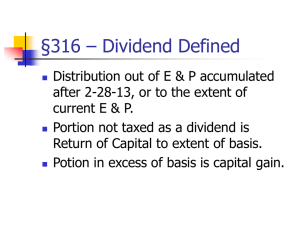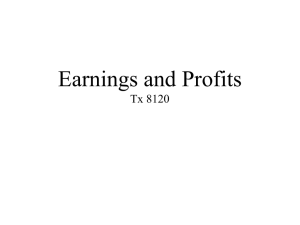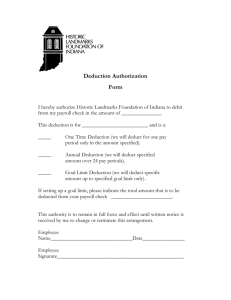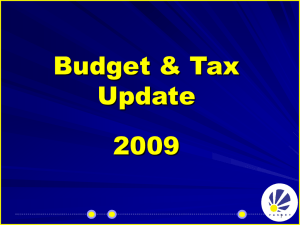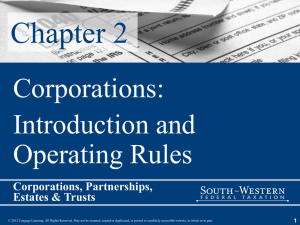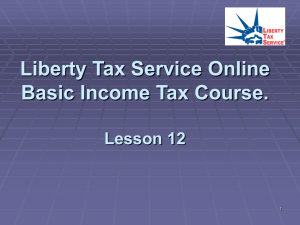ACC 570 CH 19 HOMEWORK SOLUTIONS PART A – CORPORATE
advertisement
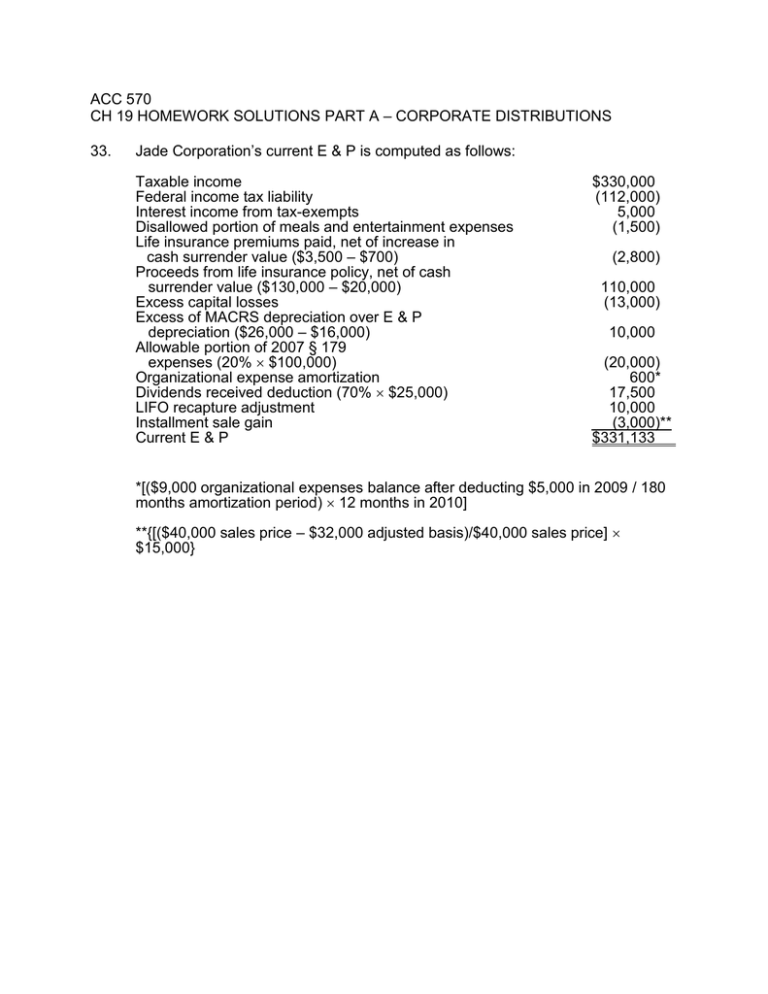
ACC 570
CH 19 HOMEWORK SOLUTIONS PART A – CORPORATE DISTRIBUTIONS
33.
Jade Corporation’s current E & P is computed as follows:
Taxable income
Federal income tax liability
Interest income from tax-exempts
Disallowed portion of meals and entertainment expenses
Life insurance premiums paid, net of increase in
cash surrender value ($3,500 – $700)
Proceeds from life insurance policy, net of cash
surrender value ($130,000 – $20,000)
Excess capital losses
Excess of MACRS depreciation over E & P
depreciation ($26,000 – $16,000)
Allowable portion of 2007 § 179
expenses (20% $100,000)
Organizational expense amortization
Dividends received deduction (70% $25,000)
LIFO recapture adjustment
Installment sale gain
Current E & P
$330,000
(112,000)
5,000
(1,500)
(2,800)
110,000
(13,000)
10,000
(20,000)
600*
17,500
10,000
(3,000)**
$331,133
*[($9,000 organizational expenses balance after deducting $5,000 in 2009 / 180
months amortization period) 12 months in 2010]
**{[($40,000 sales price – $32,000 adjusted basis)/$40,000 sales price]
$15,000}
34.
a.
b.
c.
d.
e.
f.
g.
h.
i.
Taxable Income
Increase (Decrease)
$20,000
($36,000)
No effect
$9,000
($60,000)
($60,000)
No effect
($90,000)
No effect
E & P Increase
(Decrease)
No effect
$33,900*
$140,000
$21,000**
$60,000
$48,000***
($12,000)†
($10,000)††
($50,000)
*Although mining exploration costs are deductible in full under the income tax,
they are amortized over 120 months when computing E & P. Since $300 per
month is amortizable ($36,000/120 months), $2,100 is currently deductible for
E & P purposes ($300 × 7 months). Thus, of the $36,000 income tax deduction,
$33,900 is added back to E & P ($36,000 – $2,100 deduction allowed).
**The receipt of a $30,000 dividend generates a dividends received deduction of
$21,000 with a net effect on taxable income of a $9,000 increase. For E & P
purposes, the dividends received deduction is added back.
***Only 20% of current-year § 179 expense is allowed for E & P purposes. Thus,
80% of the amount deducted for income tax purposes is added back.
†In each of the four succeeding years, 20% of the § 179 expense is allowed as a
deduction for E & P purposes.
††ADS
straight-line depreciation is allowed for E & P purposes; thus, E & P is
decreased by $10,000 (the excess of ADS depreciation over the amount
allowed under MACRS).
36.
a.
b.
Amount
Taxable
Return of
Capital
$ 70,000
$60,000
Taxed to the extent of current E & P.
$70,000
Accumulated E & P and current E & P netted
on the date of distribution.
$140,000
c.
$150,000
$ -0-
Taxed to the extent
accumulated E & P.
of
current
and
d.
$ 80,000
$50,000
Accumulated E & P and current E & P are
netted on the date of distribution. There is
a dividend to the extent of any positive
balance.
e.
$100,000
$30,000
When the result in current E & P is a deficit for
the year, the deficit is allocated on a pro rata
basis to distributions made during the year. On
June 30, E & P is $100,000 [current E & P is a
deficit of $20,000 (i.e., 1/2 of $40,000) netted
with accumulated E & P of $120,000].
43.
Sandpiper owns 25% of Owl. Owl distributes land (FMV=50; basis=80), subject
to 40k debt.
a.
Sandpiper Corporation has dividend income of $10,000 [$50,000 (fair market
value of the land) – $40,000 (liability on the land)]. The $10,000 dividend creates
an $8,000 dividends received deduction under § 243. Consequently, only $2,000
of the dividend is subject to tax. Sandpiper Corporation has a basis of $50,000 in
the land.
b.
Owl Corporation may not deduct the loss on the land. Its E & P is reduced by
$40,000 [the $80,000 basis of the land (which is greater than the fair market
value) – the $40,000 liability on the land]. Balance is now $120,000.
